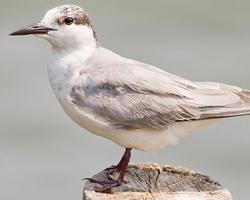
Statut de conservation
| Menacé |
Description de l'animal
The South American Tern, scientifically named Sterna hirundinacea, is a captivating bird species that graces the skies and shores of South America with its presence. As a member of the Laridae family, which includes gulls, terns, and skimmers, this bird is an exemplary figure of grace and agility, particularly noted for its remarkable fishing skills and distinctive appearance.Physical Description
Adult South American Terns are medium-sized birds, typically measuring between 41 to 46 centimeters in length, with a wingspan that can stretch up to about 95 to 100 centimeters. They exhibit a sleek and streamlined body, a hallmark of species that are adept at both flying and diving. The plumage of these birds is predominantly grey and white, which not only provides them with a degree of camouflage against the sea and sky but also adds to their striking appearance. During the breeding season, adults boast a black cap that extends from the bill to just behind the eyes, contrasting sharply with their white forehead and cheeks. Their underparts are white, blending seamlessly into the grey of their upperparts and wings. The tail is deeply forked, a characteristic feature of terns, which aids in their aerial maneuverability.
Habitat and Distribution
The South American Tern is found along the coasts and offshore islands of southern South America, from Chile and Peru on the Pacific side, around the southern tip of the continent, and up to southern Brazil on the Atlantic side. During the non-breeding season, their range expands northward, reaching as far as the coasts of Ecuador and Uruguay. They are predominantly coastal birds, although they can occasionally be spotted inland, near lakes and large rivers. Their habitats include a variety of coastal environments, such as sandy beaches, rocky shores, and estuaries, where they nest and feed.
Behavior and Diet
These terns are highly skilled fishers, often seen hovering over the water, scanning for fish before plunging down to snatch their prey with remarkable precision. Their diet primarily consists of small fish, which they catch by performing dramatic dives into the water. They are also known to feed on crustaceans and insects, particularly during the breeding season when energy demands are high.
Reproduction
South American Terns are monogamous birds, forming long-term pair bonds. Their breeding season varies depending on their geographical location but generally occurs during the southern hemisphere's spring and summer months. They nest in colonies on sandy or rocky islands, where they lay one to three eggs in a shallow scrape on the ground. Both parents share the responsibilities of incubating the eggs and feeding the chicks. The young terns fledge about a month after hatching but remain dependent on their parents for food for several weeks thereafter.
Conservation Status
Currently, the South American Tern is not considered to be at immediate risk, and the International Union for Conservation of Nature (IUCN) lists it as Least Concern. However, like many seabirds, it faces threats from habitat loss, pollution, and human disturbance, particularly in nesting areas. Efforts to monitor populations and protect critical habitats are crucial to ensuring the future of this elegant and efficient seabird.
In summary, the South American Tern (Sterna hirundinacea) is a remarkable bird species that embodies the wild beauty and ecological richness of the South American coasts. Its presence along the shorelines and in the skies above is a testament to the resilience of nature and the interconnectedness of marine ecosystems.
Animaux similaires
Nouvelles photos d'animaux
Top 10 des animaux
- Dolphin gull (Leucophaeus scoresbii)
- Diana monkey (Cercopithecus diana)
- Moustached guenon (Cercopithecus cephus)
- Galápagos tortoise (Geochelone nigra complex)
- Stone loach (Barbatula barbatula)
- Japanese macaque (Macaca fuscata)
- Russian tortoise (Testudo horsfieldii)
- Greek tortoise (Testudo graeca)
- Common flying dragon (Draco volans)
- Vendace (Coregonus albula)


